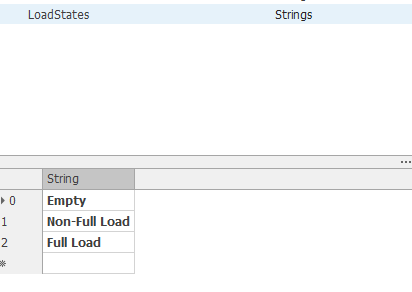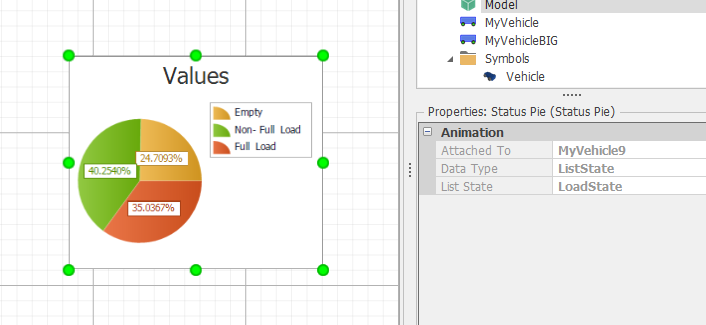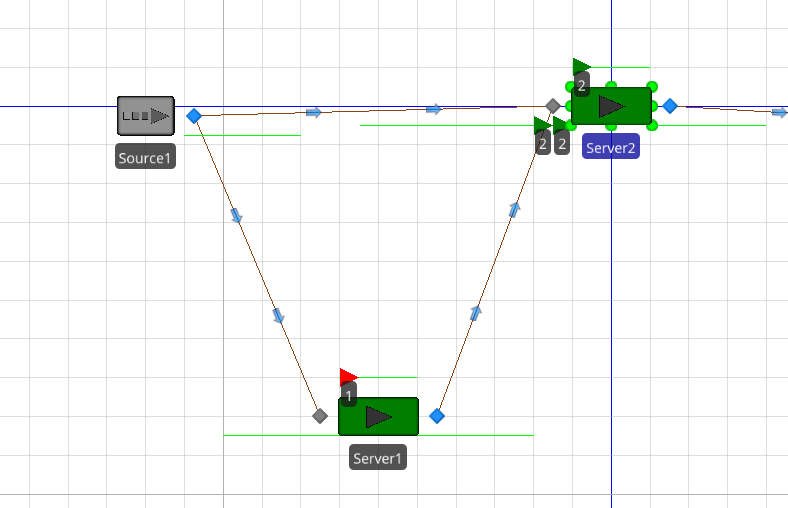Search the Community
Showing results for 'tally wait times'.
-
Hello, I have a network with one source and different sinks. I use add on process on the output of my source to choose the sinks based in the capacity. When I run the model, all created entities destroyed in the sinks correctly but in result part, "TimeInSystem" is equal zero. Due to add on process, is it happen?Should I calculate time in system with Tally? Best, Nadere
-
Hi Tom, thanks for your help! I've found a solution on my own in the meantime (probably not as sophisticated as yours but it works well). I additionally modelled a small version of the lift itself and created a wait process. The triggering event is "vehicle exits Node X". I used the process for my servers ("after processing"). So whenever a chair exits the node, the gates will open. This is actually quite close to reality where the gate opening interval is not fixed but depends on the speed of the lift and the point in time when an empty chair arrives. All the best, Nico
-
Hello and thanks for reading, I'm building a model that should replicate how vessels are handled within a port area. Within this area, there are multiple Terminals (servers) and ships (entities) that have to visit any number of terminals. Their processing times at each server vary. With their sequences predefined, I have managed to model this accurately, based on a first come first serve or another dispatching rule. I'd like to implement a dynamic sequence. 1) How can I model a certain degree of freedom in their sequences - e.g. a vessel is free to choose between sequence XABZ or XBAZ, depending on the queue size at A or B at the time of leaving X? However, in reality, these vessels enter the system, draft a sequence that is suitable for their loading plan, and then try to reserve serving times at the various terminals. I have tried wrapping my head around ways to model this, but can't seem to think of a way how. I could create a large amount of state variables for each server, that denotes whether or not a certain slot has been reserved, but that is not suitable for running long simulations. I read on this forum post that I could perhaps use a storage element, and store the reservations in there. How would I go about saving reservation-related information? Should I store that on the barge entity or in the terminal's reservation storage? How should I go about modelling timeslots in itself? 2) How can I model 'future' reservations of entities at the various servers? Finally, if this functions properly, and entities can request reservations at the various servers, I would like to have the servers compare all the requests at a certain cutoff time, and for all the doubly requested slots have it allocate the reservation based on the entities' characteristics. 3) Would I have to store the reservation data on both the entity and the server side for them to both make calculations with them, or is it enough to have them all on the server side, and denote whether they have been accepted with e.g. a boolean property? My apologies for the long post. Do not hesitate to ask for more information. Kind regards, Tom
-
2) How can I extract the total amount of times or distances that a vehicle is traveling empty (without load)? you should subclass the vehicle and create a list containing all the loadstus(string) and in its process logic( like OnRiderLoaded, RideStation.Exited....) you need to assign its loadstatus appropriately. then you can get the results using a pie chart:
-
Hello I am working on the road transportation problem and I use the vehicles. I have a couple of questions about the vehicle's features and usage. 1) How can I define an Off Shift for the vehicles? 2) How can I extract the total amount of times or distances that a vehicle is traveling empty (without load)? 3) Is there any way to create any response regarding the average performance of all the vehicles used (i.e. average idle time of the vehicles) to perform an experiment? Thanks, Amin
-
Hi, I am looking for an event which can be used in a Wait step in a process which is triggered by an entity finishing processing in a station. Also potentially an event which is triggered when an entity exits a station. Do I have to manually fire an event with an addon process from every station which I wish to do this?
-

Counting the number of times the capacity is increased
willem replied to slar18's topic in SI General Discussions
Hi, It seems your count work to count it amount of times it changes (NumberCashiers). (Also just try adding the 's', and/or just altering the expression of NumberCashier) I would suggest using a state statistic element, that takes Cashier.CurrentCapacity as it state variable. It will give you the average value of Cashier.CurrentCapacity over time. Regards, Willem -
If you want to see a stat in the Pivot Grid, you need to register it in a Tally step. Create a new Tally Statistics element on your Definitions tab. Add a Tally step in your process.
-
Hi, We want to count the number of time an extra counter is opened in our model. We tried adding and assign step in the capacity-logic process with the New value to NumberCashier +1 which is our state variable name. We tried referencing to it in an output statistic but it showed 0. What are we doing wrong? Apoteksimulering (1).spfx
-
Hello, I want to simulate an evacuation network problem. When a hurricane is imminent, all people want to evacuate the hazard area to safe areas. Therefore, we have a traffic jam (congestion) on the road. So, The speed of vehicles changes based on traffic. I have a couple of questions: 1) Is there any module in the Simio to consider traffic on the road instead of considering waiting time for server or transfer node. I mean that congestion embedded on the road by decreasing the speed of entities. 2) Are there any options to consider congestion such as considering a segment of a road is decomposed into cells based on the free flow velocity and length of discrete time step. By this division, vehicles can move only to adjacent cells in unit time. The connectors between cells are dummy arcs indicating the direction of flow between cells. For example, if 5 hour takes time to drive from the beginning of the road to the end, we put transfer node after each one unite of time (server---> after 1 hour--> transfer node ---> after 1 hour--> transfer node ---> after 1 hour--> transfer node ---> after 1 hour--> transfer node ---> server ). In the path, vehicles drive with fixed speed and path has a fixed capacity. Therefore, we can consider congestion if a vehicle wait to enter the path. I would be really happy if you could let me know how to consider congestion on the road. Thanks, Nadere
-
Hello, I am simulating a restaurant queue with two servers. The queue is lineal and the entity order is FIFO. The 85% of the entities goes to Server 1 and 15% to Server 2. But I need that all the entities do the same path. So, those entities that have to go to Server 2, wait till Server 1 (capacity==2) is empty, and then go to Server 2 (capacity==2) without processing in S1, and those entities that go to Server 1, then, wait till Server 2 is empty, to move on without process in Server 2. The real example is a lineal queue where you have to choose between two foods, but independently which one you choose, you do the same line, taking the food in the server you choose and waiting for the people that is in the other server to finish in order to move on and pay. How can I do it? Thank you so much.
-
Define incoming patients' admission to hospital dates as a "DateTime" Property in your table. And set "Arrival Mode" of Source object as "Arrival Table". Then, set arrival Time Property as "DateTime" property you defined. This will provide creating entities according to their admission to hospital times.
-
For each location where you want to start a time interval (Server 1 and "the very beginning" in your example) you would need to add a state to the ModelEntity (NOT to the model). Then for each place you want to end a time interval (server6, "the very end", and server4 in your example), you would need to add a TallyStatistic element and Tally and observation at the point. For example to record the time between between Server1 and Server6: create a modelentity state named TimeDepartingServer1 assign TimeDepartingServer1 the value of TimeNow when entity departs Server1 create a TallyStatistic element named Server1ToServer6Time record a Tally observation (using node or Tally step) at Server6 recording the value TimeNow-TimeDepartingServer1 to Server1ToServer6Time add a status or floor label using the expression Server1ToServer6Time.Average
-
Hi all!, would you help me with this? I want to do a discrete simulation of the current situation in a Hospital in the inpatient unit. I have the data of one year of patients, (over 18,000 people) and I want to use that data in the simulation. That would make more easy to model the server processing times, while we will use the real server times and sequences that each patient had, instead to use probabilities and distributions for the sequence and server times respectively. So, I created a table where each row represent a patient with a sequence (which bed he was assigned due to his level of acuity) and the time that he spent in that bed before he was dispatched. The are more times involve, but we can focus in those parameters to have it more simple. So, the table have the patient name (entity) ,bed (sequence) and Length of Stay in the bed (server processing time). I don't know if is possible that when I create each entity, I can assign, based on that table, the sequence and the server processing time for each patient. How I can do that? Thanks for your time and help
-
I have new question followed, eg: I have item1, item2, item3, serverA and serverB process super fast, but when they go through from server A to server B they have waiting time 3 min, 5 min, 1 min. For server B, I want to process the item who arrives first... But now it seems, item2 and item3 have to wait until item1 is done traveling which is not what I want. Because ideally we want to make improve the utilization of both servers.
-
2 Entities with different process times through Server
CWatson replied to BKerr's topic in SI General Discussions
You can do this in several different ways. If you simply have 2 entity types, an easy way to do it would be with a Math.If statement within the Processing Time property. For example, Math.If(Is.Red, 2, 4) - given you had 2+ entity types, the ones that have the entity name 'Red' would process for 2 minutes (or time units specified), all others would process for 4 minutes (time units). You can have multiple Math.If statements (Is.Red,2, Is.Green,4, Is.Blue, 5, 6), for example. Of course, you can use more complex values than 2, 4, 5 for processing times. A more flexible way would be to store the information within a table. That is, have a data table that includes the names of all the entity types in an Object Reference type (Entity) property. Then, within that column, set the Auto-set Table Row Reference property to 'True'. This way, when an entity of a given type is created, it has a reference to the row associated with its name automatically. Then, have another column of type expression (so you can specify a distribution, etc.) which includes the server processing times for each entity type. Then, within the Server, reference TableName.ServerProcessingTimeName as the processing time. -
Hi All, It's been a while since I have last used Simio and I have an issue that I think should be simple. I have two entities running on a production line, one gets processed by a server and the second entity type moves through the same server almost like a conveyor with no processing. I can work around this by adding another conveyor around the server, but in real life the product does flow through this server and eats at it's capacity. Is there anyway to set up different processing times for multiple entity types on a server? Thanks, Brendan
-
Hello! I'm trying to model an assembly line that has several unit (entity) types run down it. I have a table set up determining processing times for each entity types and that works fine. I tried the same syntax for the Reliability Logic (for both uptime between failures or count between failures and the time to repair) but I keep getting errors saying there is a problem determining the row to use in my table. I've tried different tables and several failure types and I'm stuck. I also tried add-on processes to SetRow via the Token object, but that didn't help. I even tried copying and pasting the exact same syntax I have for the processing time into the reliability logic, and it still gets stuck. Can I not call on table references in my reliability logic? Thanks! Kaylinn
-
Hi Fra, Have you tried changing the Input Buffer Capacity and Output Buffer Capacity to '0'? This will prevent the pieces from queuing in front of the servers because there is no input buffer for them to queue in. Instead, they will queue on the link leading up to the server. If you use a Path, to see pieces queue up behind one another, set the Allow Passing to 'False'. If you want the pieces wait at the current object until the downstream object is available, you can use a Connector (instantaneous travel). For a solution where travel time is required between objects, you can explore using Add-On Process Logic to prevent moving until the downstream object is available. In this instance you would use either a TimePath or Path. All the best, Caleb
-
Hello indsiders, I have the following problem, which i broke down for better understanding: The next time Server2 is free, it should select the red entity with the priority 1 (Dynamical labels notify the Entity.Priority) even if the red entity has not reached the input buffer of Server 2 at that specific time. It seems like i need a ranking expression that says: Server2 select Entity.Priority == 1 out of the input buffer. If there is no Entity that matches this condition wait until a entity with the matching condition arrives in the input buffer. I tried the seize, allocate and reserve step. But nothing is realy acceptable. I assume it's an easy problem, but after several hour of trying i gave up :(. Can someome help me ? Best regards, Benjamin
-
Node depending Crane's Load/Unload Time
gocken replied to MauricioBiolato's topic in SI General Discussions
Subclass a transfer node then define two properties: LoadTime and UnloadTime. Then use these subclassed nodes in your model and set the values of LoadTime and UnloadTime properties appropriately for each subclassed transfer nodes. Also, define two properties on modelentity: you can name them as LoadTime and UnloadTime. Then, define an entered add-on process for each subclassed transfer nodes where you should assign ModelEntity.LoadTime=LoadTime and ModelEntity.UnloadTime=UnloadTime. Now, by setting loadtime and unloadtime properties of crane object as ModelEntity.UnloadTime and ModelEntity.LoadTime you can get different times for load and unload times at different points. -
Thanks for your reply! That's something that worked indeed. Although I'd like to model it in a different way. At the moment I am trying to store the location.x of each entity in a vector, and keep this updated by using an add-on process with a loop. From there I would like to let every entity use the find step, to look for the lowest value in the list for location.x - (their own location.x). When this is done, they should switch to a boolean state in which they are trying to "couple". If this is true, these entities will not show up in the previous list with the lowest location.x. When this boolean state is active, I would like to let the entity behind speed up, until the distance between the targeted entity is for instance "1m", after that they should proceed with the same desired speed. I did find some interesting simbits which does something similar like "FindAMinimumStateValue.spfx", although. Instead of updating serverprocessing times, I would like to store the location.x of each created modelentity. Is there any way to do this?
-
If arrival rates at sources and processing rates at servers are all same there should not be any difference between these two systems. Check 1) Are the processing times of all server objects are same? 2) Are the interarrival times of source objects all same? the conveyor speeds does not affect the queue length. It does affect only finishing time of processing parts.
-
Rate Tables vs Manual Arrival Rate Changes
gocken replied to akramnajjar's topic in SI General Discussions
from exponential distribution you can get varying numbers in a very very wide range (for example, if you are using exponential distribution for generating interarrival times in one draw (random number generation) you can get 1 (say hour) and in another draw you can get 100 hours). The authors emphasizes that this situation can cause improper results in simulations due to discrete event simulation time advancement mechanism. Assume that you have periods each length is 20 hours. Note that, in discrete event simulation, i.e., the first event plans the next event. So, assume that in the first period (within the first 20 hour) the first event will be created at exactly time 1 (hour) (say an arrival event). After its creation, this entity plans the next arrival (thus an interarrival time will be generated from an exponential dist), i.e., the second entity will arrive to the system at time 101 (hour, 1+100). this means that you will have only one arrival in the first period and no arrivals in 2th,3th,4th and 5th periods. the authors says that this is an inconvenience and arrival should be planned in each period, seperately. By this way, in each period you will have at least one arrival. For this to happen you can use rate tables. -
I'm making a simple simulation model of a hospital and I'm having trouble with the routing of my model. For instance, a patient first goes through ED and then to OR. if there is no room in the OR, then the patient must stay in ED. How can I model this? I don't want the patient to wait at any input or output buffer, because then it assumes that the ED bed that the patient used to stay in is now free but it actually isn't. Each bed is modeled as a server and there are more ED beds than there are OR beds. Naturally, all ED beds connect to a single transfer node, which then connect to all OR beds.









